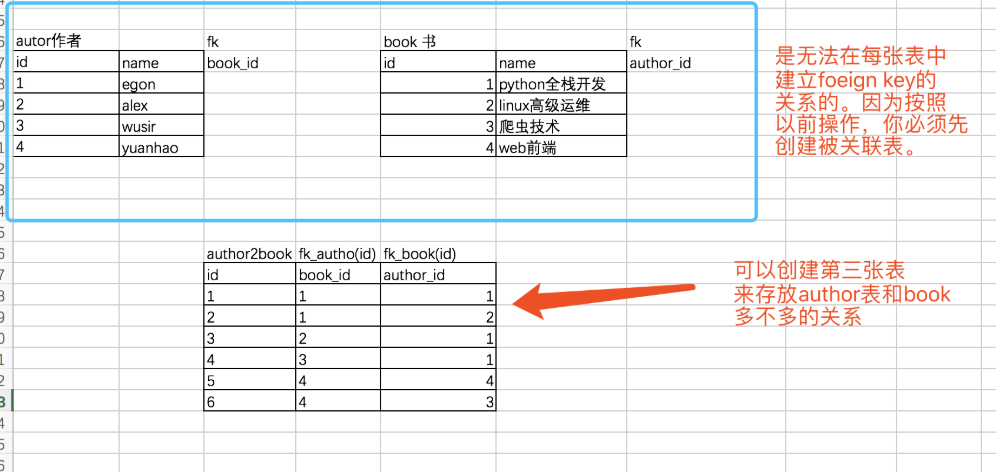一 . 外键 (多表关系)
1. foreign key (外键)
因为有foreign key的约束,使得两张表形成了三种了关系:
多对一
多对多
一对一
2、重点理解如果找出两张表之间的关系
分析步骤: #1、先站在左表的角度去找 是否左表的多条记录可以对应右表的一条记录,如果是,则证明左表的一个字段foreign key 右表一个字段(通常是id) #2、再站在右表的角度去找 是否右表的多条记录可以对应左表的一条记录,如果是,则证明右表的一个字段foreign key 左表一个字段(通常是id) #3、总结: #多对一: 如果只有步骤1成立,则是左表多对一右表 如果只有步骤2成立,则是右表多对一左表 #多对多 如果步骤1和2同时成立,则证明这两张表时一个双向的多对一,即多对多,需要定义一个这两张表的关系表来专门存放二者的关系 #一对一: 如果1和2都不成立,而是左表的一条记录唯一对应右表的一条记录,反之亦然。这种情况很简单,就是在左表foreign key右表的基础上,将左表的外键字段设置成uniq
3 .表的三种关系
(1)书和出版社
一对多(或多对一):一个出版社可以出版多本书。看图说话。
关联方式:foreign key

create table press( id int primary key auto_increment, name varchar(20) ); create table book( id int primary key auto_increment, name varchar(20), press_id int not null, constraint fk_book_press foreign key(press_id) references press(id) on delete cascade on update cascade ); # 先往被关联表中插入记录 insert into press(name) values ('北京工业地雷出版社'), ('人民音乐不好听出版社'), ('知识产权没有用出版社') ; # 再往关联表中插入记录 insert into book(name,press_id) values ('九阳神功',1), ('九阴真经',2), ('九阴白骨爪',2), ('独孤九剑',3), ('降龙十巴掌',2), ('葵花宝典',3) ; 查询结果: mysql> select * from book; +----+-----------------+----------+ | id | name | press_id | +----+-----------------+----------+ | 1 | 九阳神功 | 1 | | 2 | 九阴真经 | 2 | | 3 | 九阴白骨爪 | 2 | | 4 | 独孤九剑 | 3 | | 5 | 降龙十巴掌 | 2 | | 6 | 葵花宝典 | 3 | +----+-----------------+----------+ rows in set (0.00 sec) mysql> select * from press; +----+--------------------------------+ | id | name | +----+--------------------------------+ | 1 | 北京工业地雷出版社 | | 2 | 人民音乐不好听出版社 | | 3 | 知识产权没有用出版社 | +----+--------------------------------+ rows in set (0.00 sec) 书和出版社(多对一)
(2)作者和书籍的关系
多对多:一个作者可以写多本书,一本书也可以有多个作者,双向的一对多,即多对多。看图说话。
关联方式:foreign key+一张新的表

# 创建被关联表author表,之前的book表在讲多对一的关系已创建 create table author( id int primary key auto_increment, name varchar(20) ); #这张表就存放了author表和book表的关系,即查询二者的关系查这表就可以了 create table author2book( id int not null unique auto_increment, author_id int not null, book_id int not null, constraint fk_author foreign key(author_id) references author(id) on delete cascade on update cascade, constraint fk_book foreign key(book_id) references book(id) on delete cascade on update cascade, primary key(author_id,book_id) ); #插入四个作者,id依次排开 insert into author(name) values('egon'),('alex'),('wusir'),('yuanhao'); # 每个作者的代表作 egon: 九阳神功、九阴真经、九阴白骨爪、独孤九剑、降龙十巴掌、葵花宝典 alex: 九阳神功、葵花宝典 wusir:独孤九剑、降龙十巴掌、葵花宝典 yuanhao:九阳神功 # 在author2book表中插入相应的数据 insert into author2book(author_id,book_id) values (1,1), (1,2), (1,3), (1,4), (1,5), (1,6), (2,1), (2,6), (3,4), (3,5), (3,6), (4,1) ; # 现在就可以查author2book对应的作者和书的关系了 mysql> select * from author2book; +----+-----------+---------+ | id | author_id | book_id | +----+-----------+---------+ | 1 | 1 | 1 | | 2 | 1 | 2 | | 3 | 1 | 3 | | 4 | 1 | 4 | | 5 | 1 | 5 | | 6 | 1 | 6 | | 7 | 2 | 1 | | 8 | 2 | 6 | | 9 | 3 | 4 | | 10 | 3 | 5 | | 11 | 3 | 6 | | 12 | 4 | 1 | +----+-----------+---------+ rows in set (0.00 sec) 作者与书籍关系(多对多)
(3)用户和博客
一对一:一个用户只能注册一个博客,即一对一的关系。看图说话
关联方式:foreign key+unique

#例如: 一个用户只能注册一个博客 #两张表: 用户表 (user)和 博客表(blog) # 创建用户表 create table user( id int primary key auto_increment, name varchar(20) ); # 创建博客表 create table blog( id int primary key auto_increment, url varchar(100), user_id int unique, constraint fk_user foreign key(user_id) references user(id) on delete cascade on update cascade ); #插入用户表中的记录 insert into user(name) values ('alex'), ('wusir'), ('egon'), ('xiaoma') ; # 插入博客表的记录 insert into blog(url,user_id) values ('http://www.cnblog/alex',1), ('http://www.cnblog/wusir',2), ('http://www.cnblog/egon',3), ('http://www.cnblog/xiaoma',4) ; # 查询wusir的博客地址 select url from blog where user_id=2; 用户和博客(一对一)